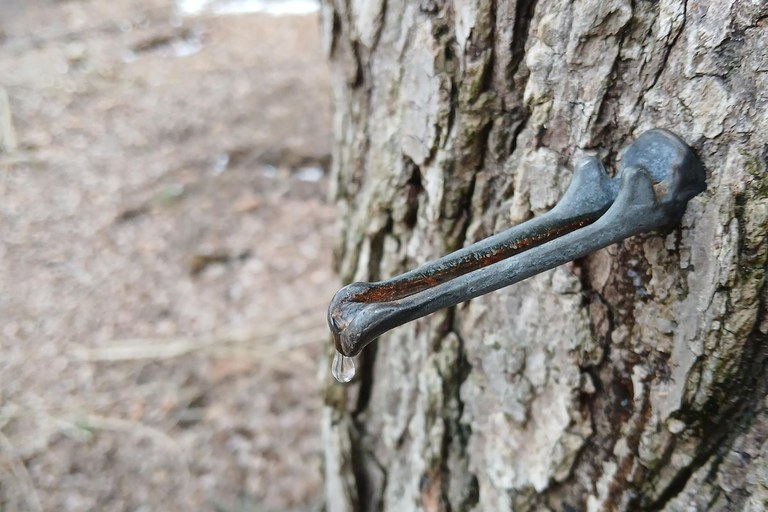Posted: February 20, 2025
The science behind maple sap flow explains why maples can be tapped to make syrup.

Sap flowing from maple tap. Photo credit: Jennie Mazzone, Penn State.
February is coming to an end. Warmer days are just around the corner, and so is maple sugaring season. Have you ever wondered how the maple tree produces the sweet sap we use to make syrup? Maple sap flow is driven by physiological processes in the tree's xylem tissue and specific weather conditions.
In plant biology, we learn that phloem tissue transports the sugars (photosynthate) within the tree, while xylem tissue transports water and dissolved minerals from the roots to the leaves. However, during the leafless, dormant period of late fall and winter, maples concentrate sugar in their xylem sap. This sugar is produced when ray parenchyma—living cells that extend horizontally through the xylem—use enzymes to convert starch into sucrose. These sugars help protect plant tissues from freezing.
Sap flows in late winter/early spring when temperatures alternate between freezing and thawing, below and above 0°C (32°F), respectively. During this time, ice crystals that formed in xylem fiber cells over the winter begin to melt. At the same time, the sucrose produced by the ray parenchyma cells becomes concentrated in the xylem vessels. These processes create positive pressure inside the tree. If the tree is tapped or wounded, the sugar-filled xylem sap leaks out because the positive pressure inside the tree is higher than outside air pressure. When nighttime temperatures drop below freezing, a negative pressure (suction) develops, drawing water into the tree from the soil to replenish what was lost. Once the freeze/thaw cycle ends and the buds break dormancy, the pressure differential inside the tree will stop, and so will the flow of sap from the tap hole.
The unique anatomy and physiology of maple trees, combined with the environmental conditions of our region, allow sap to flow. However, it is still up to us, the sugar makers, to do the hard work of collecting and boiling sap to produce the sweet, delicious maple syrup product we know and love. Starting with a higher sugar-content sap (e.g., sugar maple) can help speed up the process. To learn more about the production of maple syrup, visit the Penn State Extension website.
References
Blumenstock, M., Hopkins, K. and Lilley, J. How to Tap Maple Trees and Make Maple Syrup. The University of Maine Extension. Bulletin #7036.
Kidd, R. 2013. Why are maple trees tapped to make maple syrup? Michigan State University Extension.
Saupe, S. 2009. Biology of Maple Sap Flow. College of St. Benedict/ St. John's University. Plant Physiology (Biology 327).
Tyree, M. 1984. Maple Sap Exudation: How it Happens (PDF). Maple Syrup Journal. 4(1):10-11.
Van den Berg, A.K. 2020, February 13. The Science of Sap Flow [Webinar]. Urban Forestry Today.
Author:
Jennie Diehl Mazzone
Master Gardener Coordinator, Franklin County

